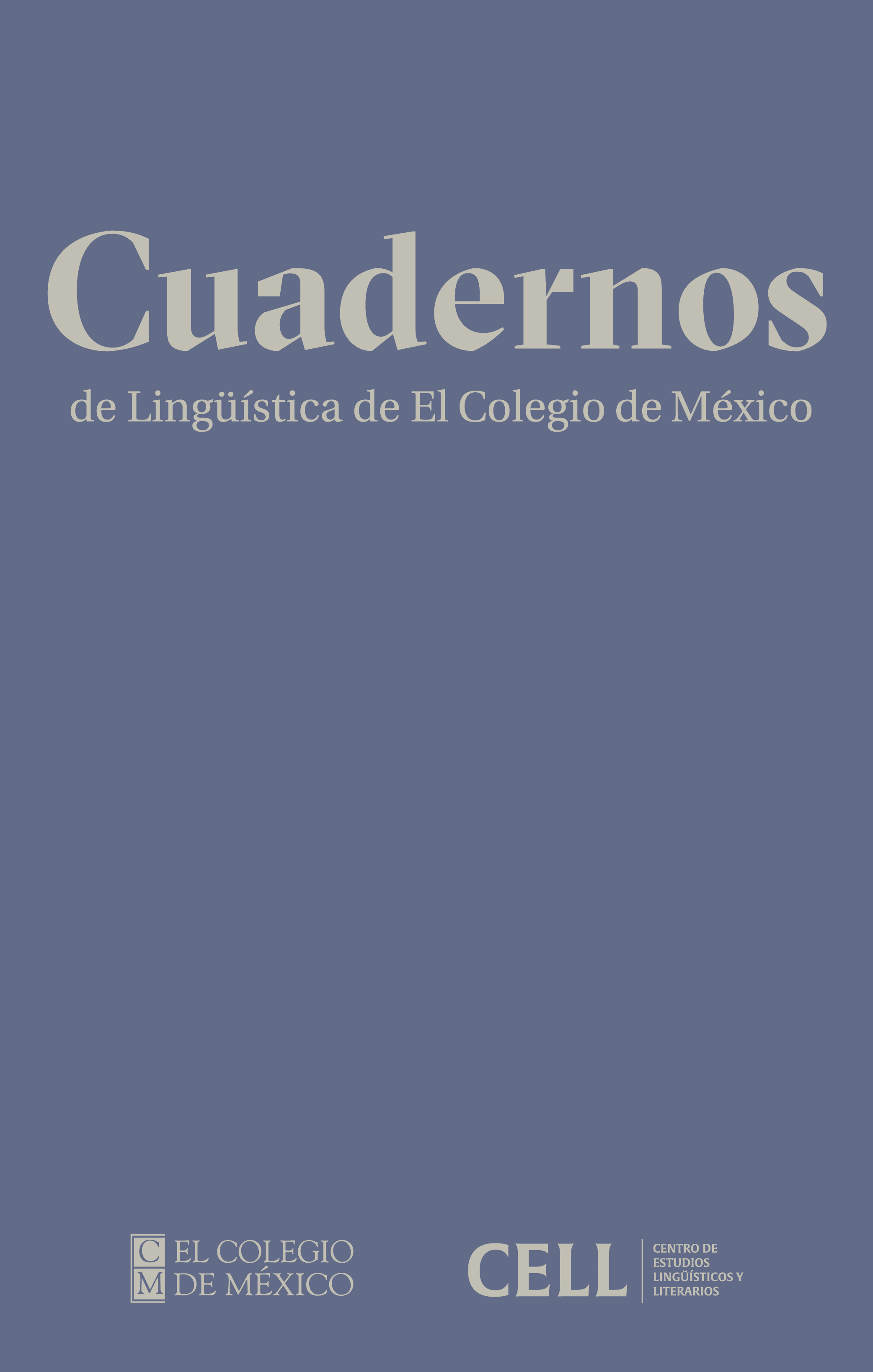Variation in the realization of vowel sequences in Mexico City Spanish: An Optimality Theory account
DOI:
https://doi.org/10.24201/clecm.v10i00.241Keywords:
hiatus, diphthong, Optimality Theory, recategorization, phonological word, Mexican SpanishAbstract
In the present article, I discuss linguistic and extralinguistic factors that condition the gliding of hiatus in Mexican Spanish under the Optimality Theory. Several hypotheses have been proposed on the gliding from hiatus to diphthongs: (i) phonetic (Chitorán & Hualde 2007); (ii) structural (Martínez-Pa-ricio 2010; 2010b; 2013); (iii) functional (=frequency) (López Escobedo 2004); and (iv) social (Vuskovich 2006). Throughout this article it is argued that the most important factor is (ii), considering that an alteration in the phonological constraint ranking is responsible for internal variation captured by the cophonology theory (Inkelas et al. 1997; Inkelas & Zoll 2007; Inkelas 2014: Chapter 2) that states that a language can have multiple grammars. This paper aims to provide an explanation of the recategorization phenomena (Ohala 1993; Hualde 2011; Company 2014) from hiatus to diphthongs for this dialect.
Downloads
References
Alarcos Llorach, Emilio. 1991. Fonología española. Madrid: Gredos.
Anttila, Arto. 2002. Variation and phonological theory. En Chambers, Jack K.; Trudgill, Peter. & Schilling–Estes, Natalie. (eds.), The handbook of language variation and change. 206–243. Cambridge MA: Blackwell. DOI: https://doi.org/10.1111/b.9781405116923.2003.00013.x
Casali, Roderic F. 1997. Vowel elision in hiatus contexts: Which vowel goes? Language 73. 493–533. DOI: https://doi.org/10.2307/415882
Chávez Peón, Mario E. 2004. Comportamiento de las secuencias vocálicas dobles en lindes de palabra en el español de nivel educativo bajo de la Ciudad de México: un análisis dentro del marco de la Teoría de la Optimidad. Memorias del primer encuentro de Teoría de Optimidad en el CIESAS. México: CIESAS.
Chitorán, Iona & Hualde, José Ignacio. 2007. From hiatus to diphthong: the evolution of vowel sequences in Romance. Phonology 24(1). 37–75. DOI: https://doi.org/10.1017/S095267570700111X
Chomsky, Noam. 1965. Aspects of the theory of syntax. Cambridge: DOI: https://doi.org/10.21236/AD0616323
MIT Press.
Clements, George N. 1990. The role of the sonority cycle in core syllabification. En Kingston, John; Beckman, Mary E. (eds.), Papers in laboratory phonology I: between the grammar and physics of speech. 283–333. Cambridge: Cambridge University Press. DOI: https://doi.org/10.1017/CBO9780511627736.017
Company Company, Concepción. 2014. Sintaxis histórica de la lengua española. Tercera parte: Adverbios, preposiciones y conjunciones. Relaciones interoracionales. Volumen 1. México: FCE/ UNAM.
Gili Gaya, Samuel. 1988. Elementos de fonética general. Madrid: Gredos.
Harris, James W. 1969. Spanish phonology. Cambridge: MIT Press. 8–9.
Hayes, Bruce & Tesar, Bruce & Zuraw, Kie. 2003. OTSoft 2.1. Software package. http://www.linguistics.ucla.edu/people/hayes/otsoft/. Google Scholar.
Hualde, José Ignacio 2005. The sounds of Spanish. Cambridge: Cambridge University Press.
Hualde, José Ignacio. 2011. Sound change and synchronic phonology. The Blackwell Companion to Phonology. Reino Unido: Blackwell Publishing Ltd. DOI: https://doi.org/10.1002/9781444335262.wbctp0093
Hualde, José Ignacio & Colina, Sonia. 2014. El acento. En Hualde,José Ignacio (ed.), Los sonidos del español: Spanish language edi-tion. 224–259. Cambridge: Cambridge University Press. DOI: https://doi.org/10.1017/CBO9780511719943.015
Inkelas, Sharon. 2014. The interplay of morphology and phonology. Oxford. Oxford University Press. DOI: https://doi.org/10.1093/acprof:oso/9780199280476.001.0001
Inkelas, Sharon & Zoll, Cheryl. 2007. Is grammar dependence real? A comparison between cophonological and indexed constraint approaches to morphologically conditioned phonology. Linguistics 45(1). 133–171. DOI: https://doi.org/10.1515/LING.2007.004
Inkelas, Sharon; Orgun, Cemil O. & Zoll, Cheryl. 1997. The implications of lexical exceptions for the nature of grammar. En Roca, I. (ed.), Constraints and derivations in phonology. 393–418. Oxford: Clarendon Press. DOI: https://doi.org/10.1093/oso/9780198236894.003.0013
Jiménez, Jesús. 1999. L’estructura sillàbica del català. València: Biblioteca Sanchis Guarner. Barcelona: Institut Interuniversitari de Filologia Valenciana, Publicacions de l’Abadia de Montserrat.
Kager, René. 1999. Optimality theory. Cambridge: Cambridge University Press. DOI: https://doi.org/10.1017/CBO9780511812408
Kisseberth, Charles W. 1970. On the functional unity of phonological rules. Linguistic Inquiry 1. 291–306.
López Villaseñor, Carlos. 2021. Variación en secuencias vocálicas en el español de la Ciudad de México. UNAM. (Tesis de maestría.)
López Escobedo, Fernanda. 2004. El estudio de los diptongos del español de México para su aplicación en un reconocedor de habla. UNAM. (Tesis de licenciatura.)
Martín Butragueño, Pedro. 2014. Fonología variable del español de México. Volumen I: Procesos segmentales. México: El Colegio de México, Centro de Estudios Lingüísticos y Literarios. (Cátedra Jai-me Torres Bodet. Estudios de Lingüística, 17).
Martínez Celdrán, Eugenio. 1984. Fonética. Barcelona: Teide.
Martínez–Paricio, Violeta. 2013. The intricate connection between diphthongs and stress in Spanish. Nordlyd 40(1). DOI: https://doi.org/10.7557/12.2505 DOI: https://doi.org/10.7557/12.2505
Matluck, Joseph 1952. La pronunciación del español en el valle de México. Nueva Revista de Filología Hispánica, 6(2). 109–120. DOI: https://doi.org/10.24201/nrfh.v6i2.248
McCarthy, John & Prince, Alan. 1995. Faithfulness and reduplicative identity. Papers in optimality theory 10. https://scholarworks.umass. edu/linguist_faculty_pubs/10
McCarthy, John & Prince, Alan. 1999. Faithfulness and identity in prosodic morphology. En Kager, R.; van der Hulst, H. & Zonneveld, W. (eds.), The prosody–morphology interface 9. https://scholarworks.umass.edu/linguist_faculty_pubs/9 DOI: https://doi.org/10.1017/CBO9780511627729.008
Morales–Front, Alfonso. 2014. Acento. En Núñez Cedeño, Rafael A.; Colina, Sonia & Bradley, Travis G. (eds.), Fonología generativa contemporánea de la lengua española, (2ª. ed.). 235–265. Washin-gton: Georgetown University Press.
Moreno de Alba, José G. 1994. La pronunciación del español en México. México: El Colegio de México.
Ohala, John. 1993. The phonetics of sound change. En Jones, Charles (ed.), Historical linguistics: problems and perspectives. Harlow: Longman.
Orgun, Cemil O. 1996. Sign–based morphology and phonology: With special attention to Optimality Theory. Berkeley: University of California. (Tesis doctoral.)
Piña Chan, Román. 1960. La región del altiplano central. Mesoamérica, ensayo histórico cultura. Memorias 6. México: INAH.
Prince, Alan & Smolensky, Paul. 1993. Optimality Theory. Constraint interaction in Generative Grammar, manuscrito, Rutgers University & University of Colorado, Boulder. Publicado en Malden, Mass. & Oxford: Blackwell, 2004. Disponible en: http://www.roa rutgers. edu/, nº 537. DOI: https://doi.org/10.1002/9780470759400
Roca, Iggy. 1986. Secondary stress and metrical rhythm. Phonology 3. 341–70. DOI: https://doi.org/10.1017/S0952675700000683
Rosenthall, Samuel. 1994. Vowel/glide alternation in a theory of constraint interaction. Amherst: University of Massachusetts. (Tesis doctoral.)
Vuskovich, Matthew A. 2006. A sociolinguistic perspective toward hiatus resolution in Mexico City Spanish. LSU. (Tesis de maestría.)
Wright, Richard. 2004. A review of perceptual cues and cue robustness. En Hayes, Bruce.; Kirchner, Robert.; Steriade, Donca. (eds.), Phonetically based phonology, 34–57. Cambridge: Cambridge University Press. DOI: https://doi.org/10.1017/CBO9780511486401.002
Published
How to Cite
-
Abstract911
-
PDF (Español)372
-
XML (Español)62
-
EPUB (Español)66
-
Kindle (Español)148
-
MP3 (Español)33
Issue
Section
License
Copyright (c) 2023 Carlos Alfredo López Villaseñor

This work is licensed under a Creative Commons Attribution-NonCommercial-NoDerivatives 4.0 International License.
Authors retain copyright of their work and are free to disseminate it, make copies for any use, and/or deposit in any repository or archive of their choice, but they grant Cuadernos de Lingüística de El Colegio de México the right to publish the work for the first time. Authors agree to acknowledge Cuadernos de Lingüística de El Colegio de México as the site of original publication of their article / note / review through proper citation.
Articles appearing in Cuadernos de Lingüística de El Colegio de México are made available to readers under a Attribution-NonCommercial-NoDerivatives 4.0 International.









